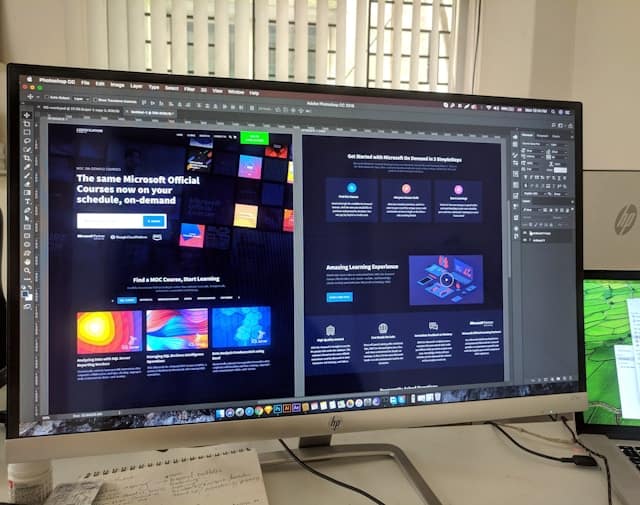In the digital era, where online presence is paramount for businesses, the importance of website design cannot be overstated. Websites serve as the digital storefronts for companies, acting as the initial point of contact for potential customers navigating the vast landscape of the internet. As such, the design of a website plays a critical role in shaping visitors’ perceptions, influencing their interactions, and ultimately determining whether they choose to engage further with the business. Businesses often turn to custom website design services to ensure that their online presence reflects their unique brand identity and offers a seamless user experience tailored to their target audience’s needs.
Importance of website design in the digital era
In today’s competitive digital landscape, where consumers have several options, a well-designed website can be a powerful tool for standing out among the competitors. It reflects the brand’s identity, values, and professionalism, conveying trustworthiness and credibility to visitors. Moreover, with most consumers turning to online channels to research products, services, and brands, a visually appealing and user-friendly website can significantly impact a company’s business by driving conversions and fostering customer loyalty.
Identifying your primary users
Understanding target audience demographics
Identifying your primary users is a crucial aspect of effective website design, as it forms the foundation upon which the entire user experience is built. Understanding the demographics of your audience is the first step in this process. By delving into factors such as age, gender, location, income level, and occupation, businesses can gain valuable insights into who their primary users are and tailor their websites accordingly.
Identifying user needs and preferences
It’s essential to identify the specific needs, preferences, and pain points of your audience. This goes beyond surface-level characteristics and delves into the motivations and behaviors that drive user interactions with your website. Conducting user research, surveys, and interviews can provide valuable qualitative data that sheds light on user preferences, challenges, and expectations.
Importance of user personas in website design
User personas are a powerful tool in website design, allowing businesses to create fictional representations of their ideal customers based on real-world data and insights. These personas encapsulate key demographic information, behavioral patterns, goals, and pain points, helping designers and stakeholders empathize with users and make informed design decisions.
Improving your visual brand
Importance of brand identity in website design
In the digital landscape, establishing a strong visual brand identity is important. Visual branding includes elements such as logos, color schemes, typography, and imagery, which collectively convey a brand’s identity and evoke specific emotions and associations among users. In website design, visual branding plays a crucial role in creating a memorable and cohesive online presence that resonates with the target audience.
Updating logos, colour schemes, and branding guidelines
To ensure relevance and consistency in visual branding, businesses must periodically evaluate and update their logos, color schemes, and branding guidelines. A modern and visually appealing logo reflects the evolving identity and values of the brand while staying true to its essence. Similarly, refreshing color schemes can breathe new life into a brand’s visual identity, aligning it with contemporary design trends and user preferences.
Examples of Inspiring Brand Guides from Leading Corporations
Examining brand guides from leading corporations offers valuable insights into effective visual branding strategies and best practices. These guides typically outline guidelines for logo usage, colour palettes, typography, imagery styles, and brand voice, providing a comprehensive framework for maintaining visual consistency and coherence.
Making mobile users a top priority
Significance of mobile responsiveness in website design
Mobile responsiveness is critical in website design due to the prevalence of mobile devices in internet usage. With an increasing number of users accessing websites through smartphones and tablets, websites must adapt seamlessly to various screen sizes and resolutions. Mobile responsiveness ensures that content is displayed optimally across different devices, providing users with a consistent and user-friendly experience. Neglecting mobile responsiveness can lead to a disjointed browsing experience, causing users to navigate away from the site, thereby impacting engagement and conversions negatively.
Impact of mobile traffic on user experience
The surge in mobile traffic has reshaped user behavior and expectations when interacting with websites. A significant portion of internet traffic now originates from mobile devices, underscoring the importance of catering to the unique needs of mobile users. Websites that are not optimized for mobile devices risk alienating a substantial portion of their audience. Mobile users demand fast loading times, intuitive navigation, and responsive design elements that enhance usability and accessibility.
Strategies for implementing mobile-first design
Embracing a mobile-first design approach involves prioritizing the development of website layouts and features for mobile devices before considering desktop users. This strategy ensures that websites are designed with the constraints and preferences of mobile users at the forefront. Key strategies for implementing mobile-first design include adopting responsive design frameworks, optimizing multimedia content for mobile consumption, simplifying navigation for touchscreens, and prioritizing content hierarchy for smaller screens.
Including calls to action
Definition and importance of calls to action (CTAs)
Calls to action (CTAs) are essential elements of website design that prompt users to take specific actions, such as making a purchase, signing up for a newsletter, or contacting the business. CTAs serve as guiding signposts that direct users towards desired outcomes, helping businesses achieve their goals and drive conversions.
Best practices for designing effective CTAs
Designing compelling CTAs involves incorporating key elements that attract user attention and motivate them to act. Some best practices for creating effective CTAs include using clear and concise language that communicates the desired action, employing contrasting colors or bold typography to make CTAs stand out, and creating a sense of urgency or incentive to prompt immediate action.
Ensuring seamless user experience with clickable
CTAs Seamless user experience is important when incorporating clickable CTAs into website design. It’s essential to ensure that CTAs are designed to be visually appealing and easily recognizable as clickable elements. This can be achieved by using intuitive design cues such as button shapes, hover effects, and interactive animations that indicate the clickable nature of CTAs.
Structuring your site for scalability
Understanding the importance of scalability in website design
Scalability refers to the ability of a website to accommodate growth and adapt to changing needs over time. In website design, scalability is crucial for ensuring that the site can handle increased traffic, content updates, and functionality enhancements without experiencing performance issues or structural limitations.
Avoiding single points of failure (SPOFs)
Single points of failure (SPOFs) are components within a website’s architecture that, if they fail, can cause the entire site to malfunction or become inaccessible. In website design, it’s essential to identify and eliminate potential SPOFs by implementing redundancy, fault tolerance, and load-balancing mechanisms.
Strategies for future-proofing your website design
Future-proofing your website design involves anticipating future trends, technologies, and user expectations to ensure that the site remains relevant and effective in the long term. This requires adopting a proactive approach to website development and incorporating flexible, modular design principles that allow for easy adaptation and expansion.
Communicating with your customers
Importance of effective communication channels on websites
Effective communication channels on websites play a vital role in facilitating interactions between businesses and their customers. They provide avenues for users to ask questions, seek assistance, and provide feedback, enhancing the overall user experience. By offering clear and accessible communication channels, businesses can build trust, foster engagement, and address customer concerns promptly.
Choosing communication methods and availability hours
Selecting the right communication methods and establishing availability hours are critical considerations for website design. Businesses need to assess their target audience’s preferences and communication habits to determine which channels—such as email, telephone, online chat, or social media—are most effective for reaching them. A
Incorporating artificial intelligence and chatbots for customer interaction
Artificial intelligence (AI) and chatbots are powerful tools for enhancing customer interaction on websites. These technologies enable businesses to automate responses to frequently asked questions, provide personalized recommendations, and offer round-the-clock support. By leveraging AI and chatbots, businesses can improve efficiency, reduce response times, and deliver seamless customer experiences.
Selecting the right content management system (CMS) for web project
A content management system (CMS) is a crucial component of website design, providing the framework for creating, managing, and publishing digital content. With numerous CMS options available, selecting the right one requires careful consideration and evaluation of various factors.
Overview of popular CMS options
WordPress, Drupal, and Joomla are among the most widely used CMS platforms, each offering unique features and functionalities tailored to different user needs. WordPress is renowned for its user-friendly interface and extensive plugin ecosystem, making it ideal for bloggers, small businesses, and e-commerce websites. Drupal, on the other hand, is known for its robust security features and scalability, making it suitable for complex enterprise-level projects. Joomla strikes a balance between ease of use and flexibility, making it a popular choice for community-based websites and online magazines.
Factors to consider when choosing a CMS for your website
When selecting a CMS for your website, several factors should be taken into account. These include ease of use, scalability, customization options, security features, community support, and integration capabilities with third-party tools and services.
Consulting with the website design team for informed decision-making
Collaborating with your website design team is essential for making an informed decision when selecting a CMS. Designers and developers can provide valuable insights and recommendations based on their expertise and experience working with different CMS platforms. They can assess your specific requirements, budget constraints, and technical capabilities to help identify the most suitable CMS solution for your project.
Balancing your budget
Establishing a budget for website design projects
Before initiating a website design project, it’s crucial to establish a clear budget. The budget will guide decision-making throughout the project and ensure that expenses remain within reasonable limits. Factors such as the complexity of the website, desired features, and level of customization will influence the budgeting process.
Costs associated with custom website development vs. template design
When considering website design options, businesses must weigh the costs associated with custom development versus template design. Custom website development offers greater flexibility and uniqueness but typically comes with higher costs due to the extensive customization involved. On the other hand, template design provides a more cost-effective solution but may lack the tailored features and branding opportunities of a custom-built site.
Additional expenses for services like copywriting and SEO
Businesses must account for additional expenses related to services like copywriting and search engine optimization (SEO). High-quality content is essential for engaging visitors and conveying key messages effectively. Investing in professional copywriting services ensures that website content is compelling, concise, and optimized for search engines, improving visibility and driving traffic to the site.
Delegating roles ahead of time
Importance of assigning roles and responsibilities in website projects
Effective delegation of roles and responsibilities is essential for the success of website projects. Assigning clear roles ensures that tasks are completed efficiently, deadlines are met, and project objectives are achieved. By defining responsibilities upfront, team members understand their roles in the project and can collaborate more effectively to deliver quality outcomes.
Tasks involved in website content creation
Website content creation involves various tasks that require coordination among team members. These tasks may include collecting information for website content, compiling artwork, logos, and images, writing website copy, defining privacy policies, and reviewing and approving design concepts. By delegating specific responsibilities for each task, businesses can streamline the content creation process and maintain consistency throughout the website.
Ensuring a streamlined web design process through effective delegation
Effective delegation streamlines the web design process, minimizes delays, and enhances overall project efficiency. By delegating tasks to individuals with the necessary expertise and resources, businesses can leverage their team’s strengths and maximize productivity. Regular communication and collaboration among team members ensure that everyone remains aligned with project goals and timelines, enabling smooth progress from initial concept to final implementation.






Leave a Comment